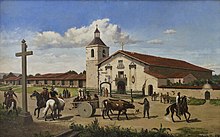Tamien people
[4] Father Pena mentioned in a letter to Junipero Serra that the area around the mission was called Thamien by the native people.
[9] Tamien territory extends over most of the present day Santa Clara County, California, and was bordered by communities that spoke other Ohlone languages: Ramaytush to the northwest on the San Francisco Peninsula, Chochenyo, East Bay, Mutsun, south of San Martin, and the Awaswas to the southwest.
In 1925, Alfred Kroeber, then director of the Hearst Museum of Anthropology, declared the Ohlone extinct, which directly led to the historic Verona Band of Alameda County (whose lineal descendants established the unrecognized Muwekma Ohlone Tribe) losing federal recognition and land rights.
[10] Land claims made by the Muwekma Ohlone Tribe have caused great confusion about which entity represents Tamien people.
While Muwekma claims to be "comprised of all known surviving American Indian lineages aboriginal to the San Francisco Bay region who trace their ancestry through Mission Dolores (Ramaytush), Santa Clara (Tamien), and San Jose (Chochenyo)," this statement is false and the tribe is mainly comprised of lineages with ancestral connections to the Pleasanton Rancheria.

